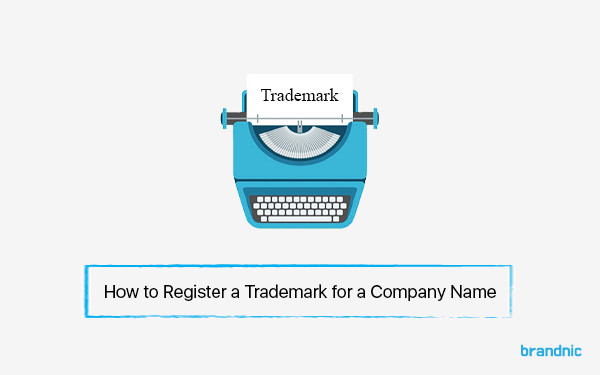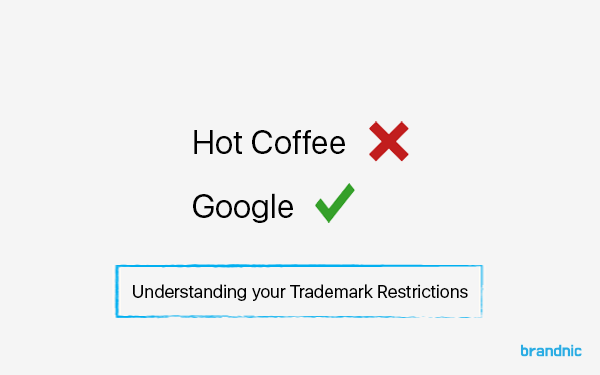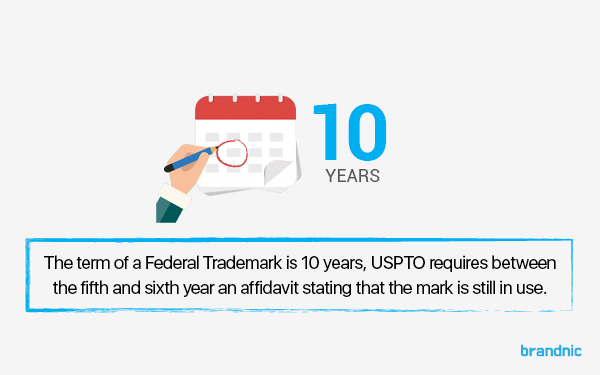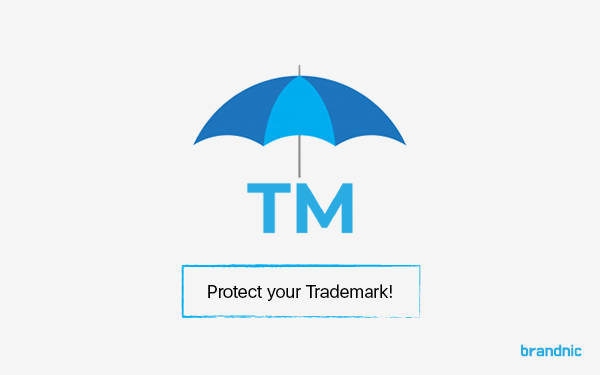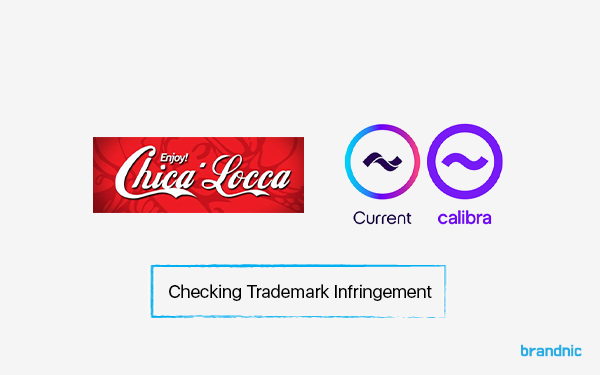Read Time: 12 minutes
Table of Contents
1. What Is a Trademarked Slogan?
2. Things to Avoid When Trademarking a tagline
3. Slogans that can’t be trademarked
4. Why a Trademarked Slogan or a Tagline is important
5. Coming up with a Slogan
6. Essential Steps to Trademark Your Name or Phrase
7. Advantages of Trademarking a Slogan
8. Disadvantages of Registering a Trademark
9. Frequently Asked Questions
The identity of your company is more profound than the logo and name that appears on your website, business card, or letterhead.
If you look at the leading companies in the world right now, you’ll notice they have some sort of phrase they always use.
This phrase is frequently used to summarize and enhance their brand identity. It can come in the form of a tagline, motto, slogan or a catchphrase.
When a slogan is used effectively, it goes a long way in contributing to the company’s perception by the public. It complements the company’s logo, name, service, and product.
The question in the mouth of most business owners is: how to trademark a phrase?
We’ve listed the steps and everything you need to know that will make the process as easy as possible for you.
What Is a Trademarked Slogan?
First and foremost, it is essential that you understand what a trademark is … A unique symbol or motto that differentiates a company or product from another business.
When you register a trademarked slogan, you are taking your business a step higher. You’re creating a connection between your brand and the message you’re sending to customers.
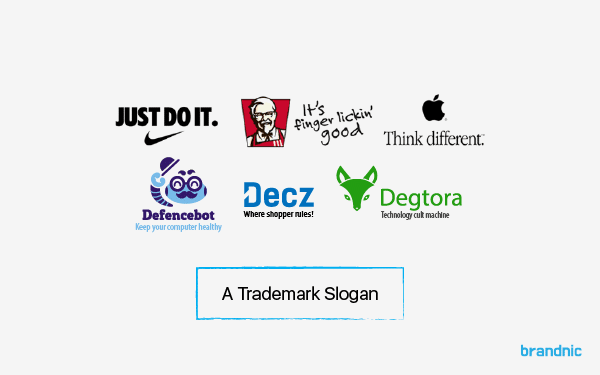
Slogans registered as a trademark.
This will also go a long way in enhancing your marketing efforts. At the same time, it’ll also add immense value to your company.
The moment you trademark a phrase or slogan, your company has the exclusive right to use the slogan to make money.
At any time, you can protect your business idea and slogan from infringements of any kind. That’s not all, you can also take infringers to court and sue for damages.
Things to Avoid When Trademarking a tagline
A common mistake made by most businesses is that they register ad campaigns as trademarked slogans. They are two different things. Before you can trademark a slogan, the following definitions have to be met:
The slogan has to be catchy and creative to leave an impression on the audience.
Take a look at the American food chain, KFC, and their “Finger Lickin’ Good” slogan.
It has a different meaning that instantly brings a smile and a feeling of something very tasty.
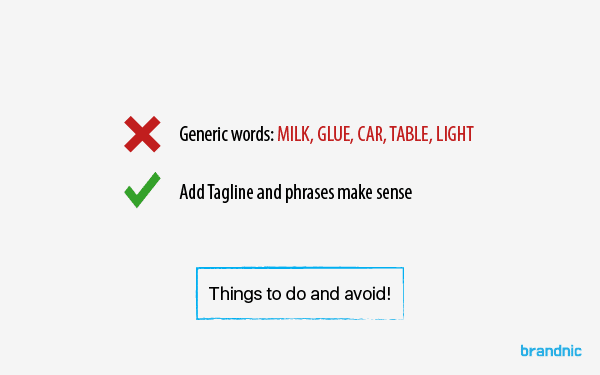
Generic words not to be used when registering a trademark.
Slogans like this are very common when they are being used in advertising or commerce.
It also has to be used consecutively for nothing less than five years.
A perfect example of a tagline like this is “America Runs on Dunkin” by, Dunkin’ Donuts.
Slogans that can’t be trademarked
Keep in mind that you can’t trademark every slogan you come across.
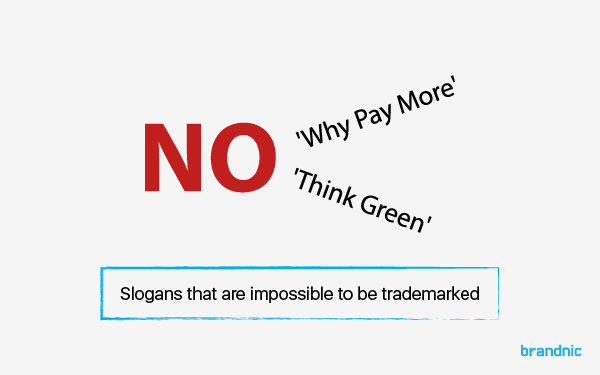
Some slogans can’t be registered as a trademark
Eventually, it is impossible to get approved for a Trademark for generic words, some of them denied trademark slogans examples are:
- Walmart – Trademark Denied
Words or tagline which has generic meaning, An example of such is from Walmart, who wanted to trademark “The yellow smiley face design” got denied as the court strongly ruled that the smiley face is public domain.
- Harley Davidson – Trademark Denied
Tagline or phrases use common products or services promotional words like Harley Davidson, who wanted to trademark “The sound of a revving engine” got denied due to other manufacturers complained that their engines sounded exactly the same.
In all situations, the intellectual property that will be trademarked must be distinctive and unique.
The same way you can trademark a slogan, it can also be done to a logo, business name, symbol, phrase or a blend of various elements
Why a Trademarked Slogan or a Tagline is important
A slogan “such as a tagline or phrase” can attain value over time. It can also play a significant role in the success of your business.
So it is vital to protect any phrase you use to safeguard the identity of your company against infringements. This can only be done by registering the slogan for trademark.
Once this is done, you are protected by law throughout the country. Your competitors or other similar businesses cannot hinder your success by making use of a similar phrase to promote or sell their goods and services.
Let’s go into details of the kinds of phrases or slogans that can be trademarked. We’ll also talk about the steps to take to register them.
Most times, people get confused when the issue of trademarking a phrase arises. This becomes more difficult when they discover how many everyday and common phrases are registered with the U.S. Patent and Trademark Office.
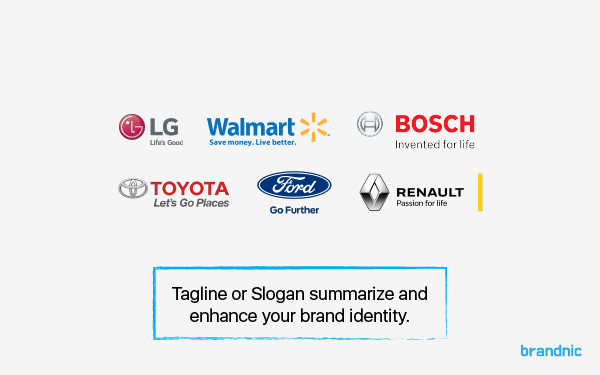
Importance of Registering a Slogan – A Brand Identity.
Understand that registering a trademark does not stop the use of the phrase in future use. What it does is to strictly prevent your competitors from using the phrase or anything similar in selling a service or product like yours.
Coming up with a Slogan
After several brainstorming sessions, you’ve settled on a slogan – the perfect combination of brief, witty and informative.
You display it conspicuously on all your marketing messages, social media, and website. The best part is, your customers are not just responding well to it, they also love it.
At this moment, even though you haven’t filed any paperwork, a trademark has already been created.
One good thing going on for your business is that you are protected locally from all kinds of infringement attempts on your right to profit from the phrase you’ve chosen.
With the amount of effort you had to put into coming up with an awesome tagline, the ideal thing to do is to ensure you no one can profit from it. Regardless of the company’s size and location.
Keeping the slogan exclusively to yourself is the next step.
To do this, you would have to file a registration with USPTO (the United States Patent and Trademark Office)
Essential Steps to Trademark Your Name or Phrase
The first step in this process is to carry out a search of registered marks. This is to ensure that you are actually the first to use this phrase for your business.
Do a Trademark Search:
- Go through the TESS database of USPTO to ensure that your chosen slogan has not been trademarked by another person.
- The moment you’ve confirmed this, you can now submit a trademark application to the USPTO.
- Once your application is received, the review process will start immediately.
After you’ve submitted your slogan application with the USPTO. You have to pay the filing fee to continue the process.
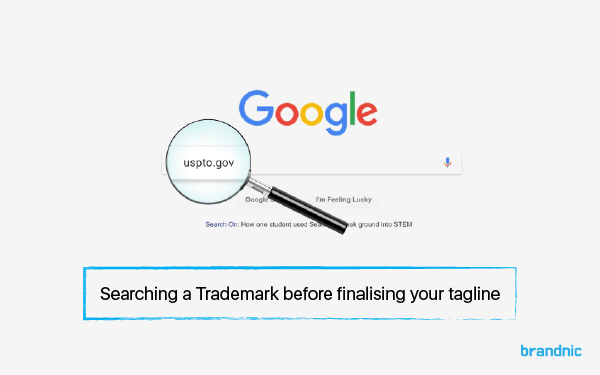
Searching USPTO to ensure that the phrase is original.
Your application should contain:
- Specimen of the trademark
- Statement of use
- Drawing of the trademark
- List of other established instances of the use
Now is the time to be patient, as this process may span several months. Usually, it can take between five months to a year.
During this period, here are some of the things that would happen;
An attorney will review your application. Your application will be thoroughly vetted to ensure it does not conflict or infringe upon any trademark that has been already registered.
The moment your phrase is deemed unique, it will be verified, and your application will be moved to the next stage, which is the Publication stage.
This is the stage where your trademark registration is put on a notice nationwide. In this stage, all parties are given a chance to object to your application if they believe an infringement has taken place.
The moment your phrase successfully passes through the publication stage, the attorney in charge of reviewing your application will carry out a final verification. If this is successful, congratulations, you’ve finally gotten a registered trademark. Now, you have adequately protected your slogan from any kind of infringement, thanks to your trademark registration. At this point, it may look like your job is done. On the contrary, your job is not over yet. As the trademark holder, you have to be on alert that no business infringes on your intellectual property. The ball is in your court to either be proactive or not. After 5 years, your trademark registration has to be renewed again.
Here are some things to remember.
Ideally, your slogan or phrase is considered to be “in use” the moment you start the trademark registration process.
What this means is that you have publicly declared the slogan in connection with your company or business. If the slogan does not enter the “in use” status, you’ll have to go through extra steps during registration. Also, a way to know if there’s an infringement on your trademark is if there’s a risk of confusion between your service or product with that of another company.
As a result, not every instance of the slogan is protected, only those that can be easily mistaken for your company or offering, and could pose a problem for your business.
The importance of starting the trademark registration process for your slogan cannot be understated. You need to start as soon as possible.
The trademark registration process can sometimes stretch for months but shouldn’t take more than eight months.
For months, nothing would be done on your application, but a patient wait should an objection or review occur.
You are in a favorable position to fight against an infringement claim, unlike in a situation where you have to make a claim against another person or business that may be infringing on your slogan.
This can happen if your slogan becomes a lucrative commodity faster than you expect.
By safeguarding yourself beforehand, you can avoid any form of legal problems and prospective business losses in the future.
Advantages of Trademarking a Slogan
1. Protection from other competitors
The moment you’ve registered all the basics, your slogan, name of business, logo, etc. You can carry out your operations without any worries.
This implies that other companies in the same line of business as you cannot use your slogan in any way. Should a situation like this occur, you can take them to court with an assurance that you’ll win.
2. Build a customer’s trust
When your customers identify your trademark slogan every time they buy your goods or services, they are sure that it is authentic.
This way, you get to build trust between you and your customers.
3. Your business and brand name is protected on social media
Most social media platforms like Instagram, Facebook, Twitter, and Pinterest have strict policies when it comes to trademarks.
This is the reason most businesses have social media accounts with these unique brand names. Companies trust that their interests are always protected.
If an individual or a competitor creates a page or account using your trademark slogan in any form.
There’s no need to worry, all you have to do is to provide evidence to support your claim.
In no time, the account or page will be taken down or suspended. The URL can then be used to create your own account or business page.
4. You can validate your business
Before you launch your business and you start spending lots of effort and time in brand marketing with a particular slogan. You will know if another person is using the slogan when you begin the registration process.
This way, you get to avoid the pitfall of changing your slogan over again, so your customers don’t lose touch with your business.
It would not be helpful to find out after a year or two that you need to rebrand because your chosen slogan is in use by another business.
5. Increases the value to your business
In the future, should you decide you want to sell your company, you’ll be at an advantage.
The value of your company is higher with a registered slogan when compared to a company that doesn’t have one yet.
Potential buyers are assured that they can keep the brand’s slogan for as long as they want.
6. Protection against Cybersquatting
By having a registered trademark, no one can purchase a domain name with your trademark. If it happens and you become aware of it, you can request to have it shut down. You can file this request with the domain company where the domain name was registered.
7. It is inexpensive to register a trademark.
There is an erroneous notion by lots of people that it is expensive to trademark a slogan. Nothing can be farther from the truth.
In fact, the opposite is the case. It doesn’t cost much, and it would save you a lot when compared to the stress of having an unprotected slogan.
8. You Can Lay Claim to Your Ad Campaign
There are several companies that frequently use a particular slogan in their advertising campaign.
If this situation applies to your business, it is advisable for you to get exclusive rights to that slogan.
Ad campaigns that meet the requirements above are eligible.
9. You Can Build Your Brand
The moment you have a trademark, you can stop others from using or profiting from your distinctive, and creative slogan.
This way, your business will stand out and get the attention it needs to grow. Your brand will also become more desirable to your customers.
Disadvantages of Registering a Trademark
1. Government procedures
A lot of people dread dealing with the government most of the time. This is because of how stressful it is.
The processes for registration are always long, and with several bureaucratic bottlenecks, you’ll have to wait for a long time to get what you need.
2. The amount of time and effort needed to get a trademark
Most people are always busy and do not have the time or the patience to go through with trademark registration. As a business owner, there are several things that require your immediate attention daily. It becomes more challenging if you run the entire business alone.
The paperwork to file a trademark is quite much, and you’ll have to fill out each and every one.
When you want to register, there are other things needed for you that you’ll have to get.
3. A dispute can still arise
During the waiting period, anyone who feels you’re infringing on their slogan or that you don’t have a right to a particular slogan can challenge your trademark.
The only way to settle this is in a law court and it would cost you a ton in legal fees.
4. Your Slogan Is Purely Descriptive
If your slogan falls in this category, you can’t file a trademark for it.
This means that it merely describes your company’s offerings. This falls short of the requirements by the USPTO.
5. A slogan can be yours without a trademark
Any business can adopt a slogan for their brand without registering a trademark. This leaves them vulnerable to exploitation.
To be on the safe side, and to stop others from profiting from or using it, a trademark has to be filed.
6. You don’t Use the Slogan Frequently
Even a distinctive and creative slogan might not meet the criteria for trademark. If legitimate use has not been established already, your case might not be strong enough to register your trademark. Before making a decision concerning your business, it is reasonable to consider the pros and cons. In this case, you know what you need to do.
It doesn’t matter if the process will take a while before your trademark application is accepted. In the end, the benefits your business will get from it would outweigh whatever you went through to get it.
It makes no sense to invest in a company or ad campaign that could pose a problem in the future, all because you didn’t get a trademark for your slogan.
Frequently Asked Questions
1. How much does it cost to Trademark a slogan?
- The filing fee for a USPTO trademark is between $225 – $400.
- You will have to pay extra for some amendments, extensions, and maintenance.
2. How Long Does It Take to Trademark a Slogan?
- After your application has been filed, you should get a response in six months or less.
- Most trademark applications are approved by the USPTO within a year.
3. How Long Do Slogan Trademarks Last?
- When a slogan is actively used, the trademarks will last for 10 years.
- All trademarks can be renewed indefinitely.
4. Trademark Renewal
The renewal dates are very important. If they are ignored, the USPTO will be forced to cancel your registration.
- Apart from the requirement to show that you’re using your trademark frequently, you have to renew the registration every ten years.
- The renewal usually costs more. Presently, the government fee is pegged at $300 for each class of goods or services.
- The renewal and The Declaration of Use are done through the official website of the USPTO website. This is done via TEAS, the agency’s electronic filing system.
- The required data can be entered in a form, credit card information, and upload images, and you’ll get a confirmation by email.
- All dates for renewal are measured from the date your trademark registration was issued. It is important not to confuse this for the date the application was filed or the date the application was published.
5. What slogans you can’t trademark
These slogans you can’t make your trademark
- You can’t trademark an Informational slogan.
- You can’t trademark slogans that are entertaining or informational nature especially if they’re nonprofit.
6. Trademarking Mere Ornamentations are not allowed
Some trademarks contain original designs. All design elements must be important to a logo.
The USPTO does not allow trademarks for elements made just for looks. In addition, the USPTO does not grant trademarks for artworks that are original.
7. Not Using Your Trademarked Slogan
If you do not have intentions of using a slogan, you should not file a trademark application. This often leads to trademark cancellation, abandonment, and nonuse.
When this happens, other parties or businesses can use abandoned or canceled trademarks. The moment you do this, the possibility of losing your exclusive rights increases.
8. Not Maintaining Your Trademark
As required by the USPTO, all trademark owners are mandated to continue registration so the trademark can be kept active. You have to show continuous use five years after your first trademark date. You also need to request it’s renewal every ten years.
If this necessary maintenance is not done, the USPTO will not hesitate to cancel the trademark.
9. If my slogan is trademarked in the USA, does it works for the rest of the world?
According to The U.S. Patent and Trademark Office, if a slogan is trademarked in the US, it doesn’t apply to the rest of the world. Trademarks and Patents are territorial. To be recognized outside the shores of America, it must be filed in every country they seek protection.
If you are looking to trademarking a business, read our guide about How to Trademark a Company Name
There are several ways to register a trademark internationally without the need for registering in each country. The international registration system is known as the Madrid Protocol or Madrid system.
